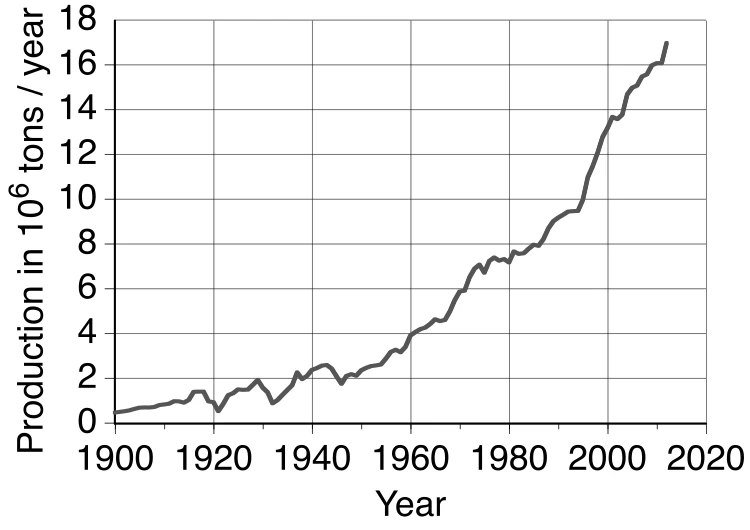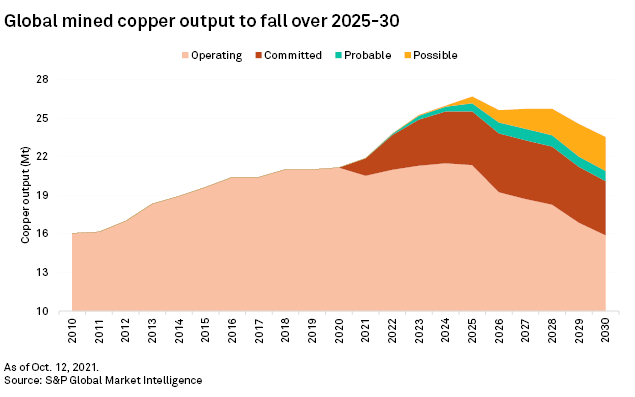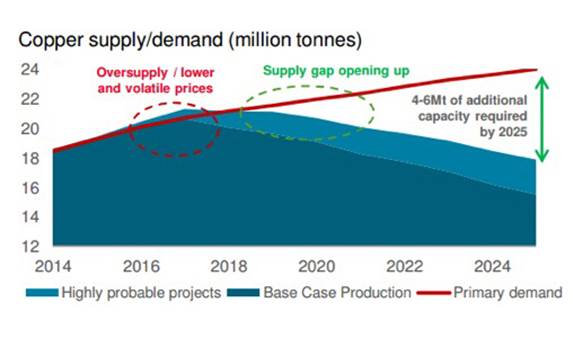Introduction to the ‘Copper Crunch’
The 'copper crunch' refers to a looming deficit in global copper supply characterized by increasing demand and diminishing resources. Copper is a critical industrial metal that used in a myriad of sectors including electronics, construction, transportation, and renewable energy technologies.
Growth in these sectors, and in particular electric batteries for electric cars, has vastly increased demand for copper:

Significance of Copper in Society Today
Copper is virtually omnipresent in modern society. It's used in myried industries and process because it has high electrical and thermal conductivity, coupled with its ductility. It's used all around us; from electrical wiring in homes, to components in our phones, laptops and screens, to high voltage transmission gear that transports electricity. Society literally cannot function (or exist) without abundant copper.


Worldwide copper demand has grown inexorably over the last 100 years. Conversely, copper supplies are diminishing. Many of the easiest to exploit and highest grade copper deposits have already been exploited, and remaining reserves are often lower in grade, more difficult or more expensive to extract, and/or located in more hostile territory.

Consequently, it is predicted that continued growth in global copper demand will not be met by current and projected future production and reserves, creating a gap between supply and demand. This gap, and the consequent impact on society, is referred to as the 'copper crunch':

Historical Context
The Evolution of Copper Usage
Copper has been used by humans for millenia, and there is evidence of its use dating back to ancient civilizations. Its applications have evolved markedly, shifting from rudimentary tools and adornments to complex machinery and advanced technology components, but it has always been a crucial an ubiquitous part of modern human evolution.
Demand for copper has witnessed a steady and inexorable rise of the millenia, centuries and decades leading to the present day. Demand has been fueled by population growth, urbanization, and technological advancements (electricity, microchips, personal electronics etc.). Periodic 'copper crunches' have arisen sporadically in the past, as copper demand exceeds copper supply, but in each case the balance has been restored either through the discovery of new reserves or through technological innovations augmenting existing supply chains.
Current State of the Copper Industry
Leading Producers and Consumers
The largest producers of copper in the world are currently Chile, Peru, and China, with these nations driving the global copper industry. On the consumption front, China dominates, consuming approximately half of the world's copper production to fuel its rapidly developing economy and infrastructural advancements.


Current Demand
The escalating demand for copper can be attributed to burgeoning sectors, specifically, electric vehicles (EVs) and renewable energy technologies, both of which rely heavily on copper. Further, infrastructural developments and urbanization globally have also fueled the compounding growth in demand for copper.
Environmental Concerns
Mining Impact on the Environment
Copper mining comes with substantial environmental repercussions, including habitat destruction and pollution. The process of extracting copper from ore is energy-intensive and has been associated with detrimental environmental impacts, necessitating a reevaluation of extraction methodologies to foster sustainability.
Recycling Efforts
Given the increasing pressure on copper reserves, recycling has emerged as a crucial avenue to supplement supply. Recycling not only alleviates the strain on existing reserves but also substantially reduces the environmental impact associated with copper production.
Economic Implications
Impact on Global Economies
The copper crunch reverberates through global economies, with industries grappling with increasing costs and supply chain disruptions. This phenomenon has engendered a paradigm shift, compelling industries and governments alike to recalibrate their strategies and foster sustainable growth pathways.
Investment and Market Dynamics
The market dynamics surrounding copper are evolving rapidly, with investments pouring into exploration and new mining technologies. The sector is witnessing a surge in capital inflow, spurred by the prospects of high returns, given the increasing demand and supply constraints.
Innovative Solutions
Technological Advancements in Mining
Technological advancements have paved the way for more efficient and environmentally friendly extraction processes. Innovations such as in-situ leaching and the utilization of microorganisms to extract copper are under active research, showcasing the industry’s penchant for innovation.
Substitution and Materials Science
With copper becoming a scarce resource, there is a burgeoning interest in finding substitutes that can alleviate the demand pressure on copper. Materials science has made significant strides, offering a glimpse into potential alternatives that can partially replace copper in various applications.
Deep-Sea Mining: A New Option for Copper production
Promise of the Deep Sea
Deep sea mining has emerged as a promising yet contentious solution to the copper crunch. The deep seabed is known to house extensive mineral resources, including polymetallic nodules rich in copper, nickel, and other valuable materials. These nodules present a tantalizing opportunity to supplement the depleting land-based reserves and meet the growing industrial demand for copper.
Technological Innovations
Harnessing the wealth of the deep sea requires avant-garde technologies capable of withstanding extreme pressures and harsh environments of the deep ocean. Robotic systems, remotely operated vehicles (ROVs), and sophisticated drilling setups form part of the technological arsenal that facilitates deep-sea exploration and mining operations.
Environmental Repercussions
However, deep-sea mining is not devoid of severe environmental ramifications. The seabed is a rich, biodiverse habitat harboring unique ecosystems that remain largely unexplored. Mining activities pose a significant threat to these ecosystems, potentially leading to habitat destruction, species extinction, and disruption of deep-sea processes essential for overall ocean health.
Regulatory Landscape
Given the nascent stage of deep-sea mining and the potential environmental repercussions, the regulatory landscape governing these operations is under stringent scrutiny. The International Seabed Authority (ISA), tasked with regulating mineral-related activities in the international seabed area, finds itself at the epicenter of a dialogue that seeks to balance economic aspirations with environmental stewardship. Crafting a regulatory framework that upholds the principles of sustainable development and protects marine biodiversity remains a critical challenge.
Economic Viability and Stakeholder Perspectives
Beyond the environmental considerations, the economic viability of deep-sea mining is under examination. High capital investments, coupled with the uncertainty surrounding technological efficacy and environmental impacts, make it a high-risk venture. The stakeholders in this arena are diverse, including government bodies, environmental organizations, and private enterprises, each bringing a distinct perspective to the table. The dialogue is complex, weaving together threads of economic development, technological innovation, and environmental conservation to draft the blueprint for the future of deep-sea mining.
Looking Ahead
As the world grapples with the copper crunch, deep-sea mining stands as a frontier with the potential to unlock vast reserves of copper. Yet, it is a frontier fraught with challenges, invoking a profound responsibility to tread carefully, with a vision that prioritizes the health of our planet and its rich biodiversity. The path forward necessitates collaborative efforts, informed decisions, and sustainable approaches that ensure the extraction of deep-sea minerals aligns with the broader goals of societal development and environmental sustainability.
Conclusion
Global Implications and the Path Forward
As the world stands at the cusp of a potential copper crunch, the path forward is rife with challenges and opportunities. Stakeholders, ranging from governments to industries and environmental organizations, have a huge task ahead — forging a path that ensures a sustainable, balanced, and prosperous future.
Deep sea mining holds the potential to add significant volumes of proven and producible copper reserves to global supply. Whilst a number of environmental and international factors need finalising, it is nonetheless one of the lowest impact and potentially lowest cost sources of copper.
Deep sea mining is likely to be the solution to the 'copper crunch' and ensuring sufficient ongoing volumes of copper for use by humanity.